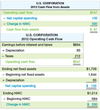Chapter 2 Flashcards
Balance Sheet Identity
Balance Sheet = Snapshot of firm, shows accounting value on a particular date
Assets = What firm owns. Current or fixed (tangible/intangible)
Liabilities = What firm owes.
Current or long-term SE/Common Equity/Owner’s Equity = Worth. If firm were to sell assets and pay off debt with the money, what’s leftover is owned by shareholders
3 main concerns: Liquidity, Debt/Equity, Market/Book
Liquidity Trade-Off
Liquidity = speed and ease with which an asset can be converted to cash without a significant loss of value.
- ↑ liquidity = ↓financial distress (paying debt/buying needed assets)
- Liquid assets are less profitable to hold, and hurt long-term solvency
∴ Tradeoff between advantages of liquidity and foregone potential profits
Debt vs. Equity
Financial Leverage = Use of debt in capital structure.
↑ debt (% of assets) = ↑leverage.
Debt = Lever because it magnifies gains and losses of wealth to the company.
Market vs. Book Value
Book = historical cost
Market = actual worth currently
-Current items might have similar market and book values
Income Statement
Income Statement = summary of performance over a period of time
Income = Revenues - Expenses
3 main concerns: GAAP & The Income Statement, Non-Cash Items, Time & Cost
GAAP & the Income Statement
Revenue Recognition Principle = recognize revenue when the earning process is virtually compete and value of exchange is known
Matching Principle = match costs with the revenues they are associated with
Non-Cash Items = expenses charged against revenues that do not directly affect cash flow
-Actual timing of cash inflows and outflows Used for a reasonable estimate of market value
Time and Cost
In the LR all business cost are variable, in SR some costs are fixed.
Product Costs = COGS, raw materials, direct labor, manufacturing overhead.
Period Costs = selling, general and administrative expenses, incurred during a time period
Taxes
Tax Reform Act 1986/Omnibus Budget Reconciliation Act 1993 = corporate tax rates are not strictly increasing (15-39%). It added the 38 and 39 tax brackets.
Average Tax Rate = Total taxes paid divided by total taxable income
Marginal Tax Rate = Amount of tax payable on next dollar
- With a flat rate, marginal is always the same as tax.
- Our corporate tax rate is a modified flat-rate tax, which becomes a true flat rate for high income (at 35%)
Cash Flow Identity
Cash Flow From Assets = Cash Flow To Creditors + Cash Flow to Stockholders

Cash Flow From Assets
- Operating Cash Flow = from daily activitiies of producing and selling. Revenues minus costs (only cash outflows)
- Net Capital Spending = money spent on fixed assets less money received form sale of fixed assets
- Change in Net Working Capital = net change in current assets relative to current liabilities for the period

Cash Flow to Creditors & Cash Flow to Stockholders
Cash Flow to Creditors = firm’s interest payments to creditors less net new borrowing
Cash Flow to Stockholders = Dividends paid out by firm less net new equity
-Together they represent net payments to creditors and owners during the year



